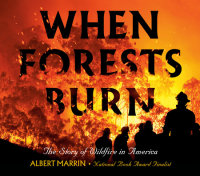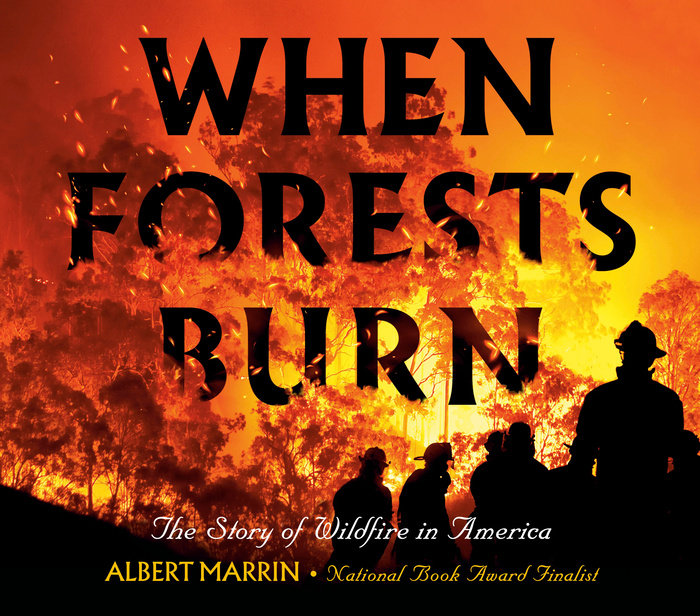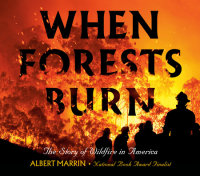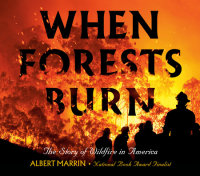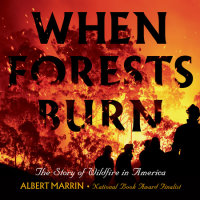When Forests Burn
A fascinating look at the most destructive wildfires in American history, the impact of climate change, and what we're doing right and wrong to manage forest fire, from a National Book Award finalist. Perfect for young fans of disaster stories and national history.
A KIRKUS REVIEWS AND BOOKLIST BEST BOOK OF THE YEAR
Wildfires have been part of the American landscape for thousands of years. Forests need fire--it's as necessary to their well-being as soil and sunlight. But some fires burn out of control, destroying everything and everyone in their path.
In this book, you'll find out about:
- how and why wildfires happen
- how different groups, from Native Americans to colonists, from conservationists to modern industrialists, have managed forests and fire
- the biggest wildfires in American history--how they began and dramatic stories of both rescue and tragedy
- what we're doing today to fight forest fires
Chock full of dramatic stories, fascinating facts, and compelling photos, When Forests Burn teaches us about the past--and shows a better way forward in the future.
An Excerpt fromWhen Forests Burn
I
ICE, FIRE, AND FOREST
From out of the north, it came. Inanimate, inexorable and indifferent: Nothing could withstand its cancerous growth. With the patience of inevitability, it slowly consumed North America. It chewed up the terrain, pulverized granite and left nothing alive in its wake. When it had grown to maximum size, some seven million square miles, it broke the back of the continent. Nothing can withstand . . . The Ice Age!
--Whit Bronaugh, “North American Forests in the Age of Nature,” 2012
About sixty years ago, my wife and I rented a small house for the summer in the Catskill Mountains of New York. We are city folk from the Big Apple, and two months in the “country” was what we needed to catch up on reading and just veg out from teaching. The house sat a little way back from a dirt road, with open woods stretching behind. One day, a neighbor, a dairy farmer, came shouting. I, dozing in a hammock, was startled awake. “Fire!” he cried. A wildfire was burning in the woods! Already, neighbors were racing toward it with rakes, shovels, brooms, and fire extinguishers. He ordered me to join them, and I did.
I remember clambering over a low wall, really an old field divider made of smooth rocks. The fire had not climbed into the trees, but its low flames moved across the ground, consuming dead leaves and brush. It was not a windy day, so the fire spread slowly, and we were beating the devil out of it. It was tricky, though: stealthily, without our noticing, it crept behind us. That was scary, but after an hour or so we put it out and headed home. On the way back, a local man said it was no big deal; fires broke out nearly every summer and fall. They came with the land. “They’ve been going on, sonny, since them lines was scratched in that boulder over there, and those fence rocks got worn smooth!” Though I didn’t know it then, this book was conceived that day.
ICE
If we could build a time machine and return to the distant past, we would not recognize our world. For the land we live on has not always been as it is today. Earth is a dynamic, restless planet, constantly changing. Nothing, however solid it may feel beneath our feet, stays the same forever. We may not notice the changes, because the individual human’s life span is short, scarcely the blink of an eye on Mother Nature’s timescale. Earth’s geological history is the story of its physical structure, the changes brought on by immense forces scientists are still learning about: earthquakes, volcanoes, and continental drift, the gradual movement of the continents across the planet’s surface over the course of millions of years. Geological history also deals with ancient mountain ranges, many times higher than today’s Rockies, rising and eventually being worn away by wind and water. Where today there are sandy deserts and rolling prairies, there were once warm seas teeming with the ferocious fifty-foot shark called the megalodon (from the Greek for “big tooth”), which makes today’s great white almost seem tame. At the same time, dinosaurs roamed the land, and pterosaurs (“winged lizards”), with wingspans ranging from nine to forty feet, filled the sky, searching for prey.
Our story begins when Earth’s climate was colder than it is today. Climate and weather, often confused, are not the same. Weather is localized and short-term. If, say, it rains for a few days where you live, that is weather. But if it rains every few days for centuries, that is climate, which is the average of weather measured over long spans of time. However, climate is far from stable; climate change, an issue of much concern today, seems never-ending. Specialized scientists called climatologists have documented five extremely cold periods, commonly known as ice ages, during the 4.6 billion years since our planet was formed. These periods, they believe, were likely caused by temporary variations in Earth’s position relative to the sun, reducing the amount of sunlight, and therefore warmth, reaching the planet’s surface.
As the climate grew colder, snow accumulated until the earlier, lower layers became so tightly packed that they solidified into ice, and the ice in turn formed glaciers. A glacier is a gigantic ice mass, weighing billions of tons. Glaciers move because weight creates pressure, and pressure creates heat, causing the ice at the glacier’s base to melt. This meltwater acts as a lubricant, enabling the glacier to slide at the rate of a few feet per year. As it advances, snow continues to build up behind it and turn to ice, causing the glacier’s continued growth. An iceberg is part of a glacier that breaks off a landmass and falls into a body of water, usually an ocean. When several glaciers come together, they form a continuous ice sheet, also called a continental glacier. What scientists call “glaciations,” or “glacial periods,” have lasted tens of thousands of years. Yet glaciations have always been followed by “interglacial periods,” during which the climate warms, causing the ice masses to retreat or melt back. Interglacial periods have lasted only a few thousand years; eventually, temperatures fell, the climate cooled again, and the glaciers resumed their advance. Climatologists believe that we are now in an interglacial period and that another ice age is coming, though nobody can say when it will occur or how long it will last. If they are right, and the pattern holds true, vast regions home to hundreds of millions of people will become totally uninhabitable. Where these climate change refugees might go, and how they could survive, would be the gravest challenge humanity has ever faced.
The most recent ice age is known as the Pleistocene Epoch, from the Greek words pleistos (“most”) and kainos (“new” or “recent”). The Pleistocene began about 2.6 million years ago and lasted until around 11,700 years ago, with about twenty periods during which the glaciers advanced, retreated, regrew, and advanced again. Today, the Antarctic ice sheet, covering 5.4 million square miles, is the largest block of ice in existence; it could cover the combined surface area of the United States and Mexico to an estimated depth of almost three miles. The Greenland ice sheet, the second largest, is much smaller, covering “only” 656,000 square miles, an area nearly three times the size of Texas. If these ice sheets melted, the level of the world’s oceans would rise disastrously, drowning low-lying islands and flooding coastal lowlands.
The opposite happened at the height of the Pleistocene Epoch. In Europe, nearly all of the western part of the continent, including the British Isles, lay under a blanket of ice. In North America, what scientists call the Laurentide ice sheet (named for a region in Canada) averaged two miles thick. Covering an area of more than five million square miles, it buried nearly all of Greenland, Canada, and the northern third of the United States. On Manhattan Island, which marked its southernmost advance, the ice is thought to have stood twice as high as the Empire State Building. We can only image the sounds that filled the air. Though there were no people to hear them, there must have been the continuous howling of the frigid wind and the snapping of trees as the moving ice cliffs slowly crushed entire forests. There was undoubtedly also the dull scraping of giant boulders caught beneath the ice, gouging out valleys and grinding hills into gravel and sand. The Rocky Mountains were buried, save for the tops of the tallest peaks, while the Adirondacks and White Mountains were worn down hundreds of feet.1
With so much water trapped as ice, the levels of the world’s oceans fell by as much as four hundred feet, causing shallow coastal areas to emerge and become dry land. Islands turned into peninsulas, portions of a mainland jutting out into a body of water. A land bridge arose where the English Channel is today, joining southern England to the European continent at France and Holland. Another land bridge emerged from beneath the Bering Strait, a water passage that now connects the Arctic and Pacific Oceans. As bridges go, this one was extraordinary; actually, it was a landmass roughly the size of the continent of Australia. Dubbed Beringia by scientists, after Vitus Bering, the Danish discoverer of the strait that bears his name, this land bridge likely stretched a thousand miles north to south and three thousand miles west to east, from Siberia to Alaska and the Yukon Territory in northwestern Canada. Evidently, glaciers were unable to form in Beringia because the climate there was too dry.
About thirty thousand years ago, bands of hunters began to trek eastward from the Asian mainland. Over decades, perhaps centuries, they moved from Siberia into western Beringia in pursuit of game. These migrants were the first humans to set foot in what European explorers would later call the Americas or the New World. What they found in Beringia was not an icy desert devoid of life, but a vast plain dotted by oases, or “refuges,” areas that supported wildflowers, shrubs, and stands of stunted willow and birch trees. Large grazing animals such as caribou, long-horned bison, antelope, camels, and woolly rhinoceros fattened on the nutritious grasses. The largest of these animals, the woolly mammoth, was the size of a modern African elephant, but had a smaller trunk, ears, and feet, adaptations to reduce the surface area exposed to the cold. It also had a thicker hide covered with long brown hair for insulation. We know this from fossilized remains found in Alaska and “freeze-dried” animals dug out of the permafrost, a layer of soil that remains frozen throughout the year. Preying on the grazers were carnivores like American lions, saber-toothed cats, short-faced bears, and dire wolves, “fearsome wolves” five feet long and weighing 150 pounds; all of these ferocious meat eaters are now extinct.2
We imagine the human hunters clad in fur from head to toe: jackets, hoods, mittens, leggings, and footwear. They must have traveled light, for their descendants, the American Indians, lacked the wheel and draft animals such as horses to pull heavy loads. They may have used the travois, a type of sledge consisting of two joined poles dragged by a person or a prehistoric dog, a creature scientists describe as “a wolf in dog’s clothing.” Though life was surely hard, the environment still provided all they needed to survive. There were wild berries to gather in season, and animals to kill for meat and for skins to fashion into clothing and shelters. To keep warm and cook meals, these Asian pioneers mostly burned bones for fuel. Scientists have found the charred remains of woolly mammoths and other animals in ancient hearths in eastern Siberia, Alaska, and Canada, proof that these hunters relied on one of nature’s most marvelous creations: fire.
FIRE
Humans have always sought to explain how we came to possess fire. One story is as good as another, for no proof exists. My favorite is an American Indian legend from an Eastern Woodlands tribe, likely one of the Iroquois group. When the world was young, it says, Fire was owned by Bear. One day, Bear set Fire down at the edge of a forest while he went with his family to raid honeybee hives. It must have gone slowly, for bees protect their precious sweet stuff by swarming thieves and stinging them in sensitive spots such as their snouts. As time passed, Fire began to get hungry; it flickered and sputtered and grew steadily smaller. In desperation, Fire cried out to Bear, “Feed me! Feed me!” But Bear didn’t come. Just then, Man walked by. When Fire said it was hungry, Man asked what it ate. “I eat sticks and wood of all kinds,” Fire replied. Man brought wood, and Fire revived, rearing up and dancing for joy. Fire warmed Man, and Man was glad. From then on, “Man and Fire were very happy together, and Man fed Fire sticks whenever it got hungry. . . . And now Fire belongs to Man.”3
Greek mythology tells a different story. A trickster named Prometheus stole fire from the gods, who lived on Mount Olympus, and gave it to humans. Angered by the theft, Zeus, king of the gods, ordered Prometheus chained to a rock, where heat tormented him by day and cold by night, and a ravenous eagle tore at him with beak and talons, eating his newly regrown liver every day.
At the dawn of science, ancient Greek and Roman philosophers taught that the universe is made up of four elements: earth, air, water, fire. However, fire is not an element in the way modern scientists define an element: a form of matter, a substance that has mass and takes up space. Technically, fire is the visible effect of matter changing form in a chemical reaction called combustion, a.k.a. burning. Three ingredients, dubbed the “fire triangle,” need to be present for fire to happen: fuel, heat, and oxygen. Fuel is anything that can burn. A fire also requires heat to raise the fuel to its burning temperature; different kinds of fuel have different temperatures at which they will ignite. Finally, a fire needs oxygen, a gas found in the atmosphere, to continue the burning process. When started, a fire will burn as long as it has the necessary ingredients to “feed” it. Should any one of them be removed, the fire will go out.
Amazingly, fire did not exist for roughly half of our planet’s history. This is because two of the fire triangle’s three “sides”--oxygen and fuel--were absent. In that long-ago time, there was only heat, from meteor strikes and lightning, a violent discharge of electricity in the atmosphere, and lava ejected in volcanic eruptions, giving off heat as a visible red glow. But heat and light are not fire.
Life gave birth to fire. While scientists do not know precisely when or how life began on Earth, they do believe that it emerged about 3.5 billion years ago, almost as soon as the planet’s surface cooled sufficiently to permit it to come into being. Apparently, the first life-forms were single-celled bacteria, microorganisms that lived in a carbon dioxide–based atmosphere. Earth’s early atmosphere was largely carbon dioxide, an odorless, colorless gas; oxygen was present only in trace amounts. About 2.3 billion years ago, certain types of microorganisms known as blue-green algae formed thin films on the surfaces of ponds, lakes, and oceans. Over time, these “scums” developed--evolved--a unique feature called photosynthesis, from the Greek photos (“light”) and synthesis (“putting together”). Photosynthesis is the ability to take energy from sunlight and use it to make food out of carbon dioxide and water. This is how all green plants get their food today.4
I. ICE, FIRE, AND FOREST
1. Rutherford Platt, The Great American Forest (Englewood Cliffs, NJ: Prentice Hall, 1965), 48, 51.
2. E. C. Pielou, After the Ice Age: The Return of Life to Glaciated North America (Chicago: University of Chicago Press, 1991), 147–148.
3. “Fire: A Myth from the Alabama Tribe,” retold by S. E. Schlosser, American Folklore, americanfolklore.net/folklore/2011/07/fire.html.
4. Riley Black, “The History of Air,” Smithsonian Magazine, April 28, 2010, smithsonianmag.com/science-nature/the-history-of-air-21082166.
